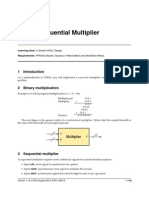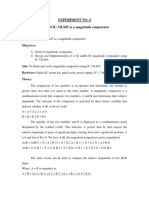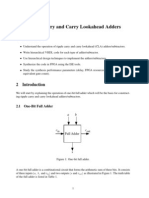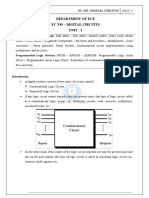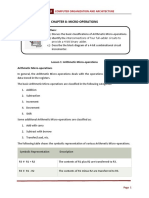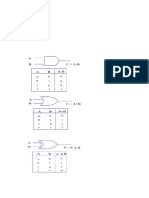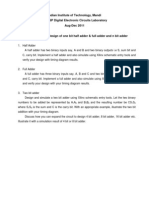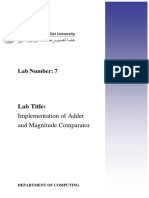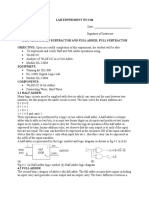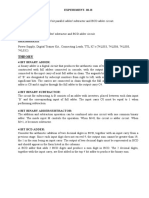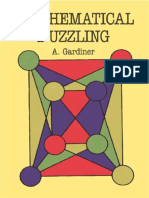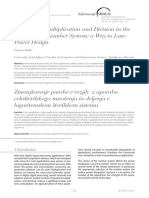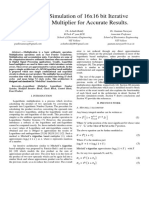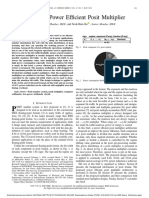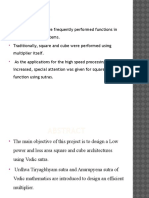EXP6
EXP6
Uploaded by
Ivan MatalaCopyright:
Available Formats
EXP6
EXP6
Uploaded by
Ivan MatalaOriginal Description:
Copyright
Available Formats
Share this document
Did you find this document useful?
Is this content inappropriate?
Copyright:
Available Formats
EXP6
EXP6
Uploaded by
Ivan MatalaCopyright:
Available Formats
Experiment 6 Arithmetic Circuits Design and Implementation Introduction:
Addition is just what you would expect in computers. Digits are added bit by bit from right to left, with carries passed to the next digit to the left, just as you would do by hand. Subtraction uses addition: the appropriate operand is simply negated before being added.
Objectives:
To understand the concept of Half and Full Adders. Design and build Ripple Carry Adder and Adder/Subtractor. Introduce two important MSI circuits: 4-bit adder and 4-bit magnitude comparator. Design and implement binary multiplier
Procedure:
Part 1: Design and Implement Adder
.Implement a half adder using an AND and an XOR gates on Multisim -1 .Design the Full Adder circuit shown in Figure 1, and then implement it on Multisim -2
Figure 1 Use the design of Full adder in step2 to implement 3-Bit Ripple Carry Adder as .shown in Figure 2 on Multisim
-3
Figure 2 Modify the circuit you built in step 4 to detect overflow and support subtraction .operation Design a 4-bit parallel adder/subtractor circuit on Multisim using the following two ICs 74LS83 (4-bit parallel adder) and 74LS86 (2-input XOR). The IC 74LS83 has two four bit number input (A4-A1), (B4-B1) and one control signal (C0) and four .output number (S4-S1) result and C4(Cout)as shown in Figure 3 When C0 = 0 the circuit works as Adder. When C0 = 1 the circuit works as Subtractor.
-4 -5
CPE 0907234 Digital logic lab Prepared by: Eng. Ala`a Arabiyat Page 1 of 2
Figure 3
Part 2: Comparator
Analyze the operation of the IC 74LS85 (4-bit Magnitude comparator), shown in -1 Figure 4, on the kit by connecting its inputs (A3-A0), (B3-B0) and the inputs (A>B, A<B, A=B) to switches and outputs (A>B, A<B, A=B) to the LEDs and then fill .Table 1
Figure 4
Inputs Input A A3 0 0 0 0 1 1 1 1 A2 0 1 1 1 0 0 1 1 A1 0 1 0 0 1 0 0 1 A0 1 1 1 1 1 1 0 1 B3 0 0 0 0 1 1 1 1 Input B B2 0 1 1 1 0 1 0 1 B1 1 0 0 0 1 0 1 1 B0 1 0 1 1 1 0 0 1 Cascade Input A>B 1 0 1 0 0 1 1 1 A<B 0 1 0 1 0 1 1 1 A=B 1 0 0 0 1 1 1 1 A>B A<B A=B Outputs
Table 1 Use Multisim to expand the 4-bit Magnitude Comparator to obtain 8 bit Magnitude .Comparator and test it -2
Part 3: Design and Implement Multiplier
Design and implement a 2-bit Multiplier that has four inputs (A1, A0, B1, and B0) and four outputs (S3, S2, S1, S0) as shown in Figure 5 using Half Adders on .Multisim -1
Figure 5 Design and implement a multi-bit Multiplier that will multiply (A1A0 B2B1B0) and produce the product (C4C3C2C1C0) using 4-bit parallel adder/subtractor on .Multisim
CPE 0907234 Digital logic lab Prepared by: Eng. Ala`a Arabiyat Page 2 of 2
-2
You might also like
- A 8bit Sequential MultiplierDocument6 pagesA 8bit Sequential MultiplierAnh Trai Em ỐcNo ratings yet
- Lab Report #5 by MungunsukhDocument7 pagesLab Report #5 by MungunsukhoyunpurevoyunaaNo ratings yet
- EXPERIMENT NO 4A and 4BDocument8 pagesEXPERIMENT NO 4A and 4BAditya PatilNo ratings yet
- AluDocument10 pagesAluAbhishek PatraNo ratings yet
- Lab6 VerilogDocument6 pagesLab6 VerilogVận MặcNo ratings yet
- Arithmetic and Logic Unit (ALU) : ALU Is Responsible To Perform The Operation in The ComputerDocument13 pagesArithmetic and Logic Unit (ALU) : ALU Is Responsible To Perform The Operation in The ComputerSAFI ULLAH KHANNo ratings yet
- Digital Electronics Module 04Document25 pagesDigital Electronics Module 04kzrdur100% (1)
- ALU unitDocument11 pagesALU unitmrhandsomboy998No ratings yet
- Arithmetic and Logic Unit (ALU) PDFDocument13 pagesArithmetic and Logic Unit (ALU) PDFnathulalusaNo ratings yet
- Exper5 Digital Adders-SubtractorsDocument5 pagesExper5 Digital Adders-SubtractorsPECMURUGANNo ratings yet
- EN TP1 DocDocument3 pagesEN TP1 DocSmail SmartNo ratings yet
- Cca 2 Fcasd - 78,89Document7 pagesCca 2 Fcasd - 78,89ayush upadhyayNo ratings yet
- CS Fall HSF Lab 3Document21 pagesCS Fall HSF Lab 3eddiemens0462No ratings yet
- EE200 Experiment 07Document5 pagesEE200 Experiment 07xanxus2012No ratings yet
- International Islamic University, Islamabad: Digital Logic Design LabDocument6 pagesInternational Islamic University, Islamabad: Digital Logic Design LabAsad Mehmood SattiiNo ratings yet
- Design of Efficient Multiplier Using VHDLDocument50 pagesDesign of Efficient Multiplier Using VHDLNagendra KashyapNo ratings yet
- Pre-Lab1 Digital DesignDocument6 pagesPre-Lab1 Digital DesignGia BaoNo ratings yet
- Ripple Carry and Carry Lookahead Adders: 1 ObjectivesDocument7 pagesRipple Carry and Carry Lookahead Adders: 1 ObjectivesMercely Christy PriyaNo ratings yet
- Design of Half Full Adder, Half Full Subtractor and Parallel AddersubtractorDocument7 pagesDesign of Half Full Adder, Half Full Subtractor and Parallel AddersubtractorMani Bharathi100% (2)
- Lab ManualDocument24 pagesLab ManualJaferNo ratings yet
- Unit 2 ALU Part 1Document7 pagesUnit 2 ALU Part 1ImranNo ratings yet
- Experiment 8Document5 pagesExperiment 8Advay JoshiNo ratings yet
- Department of Ece Ec T45 - Digital Circuits Unit - 3Document41 pagesDepartment of Ece Ec T45 - Digital Circuits Unit - 3thiruct77No ratings yet
- CA PracticalDocument29 pagesCA PracticalDurgesh DhoreNo ratings yet
- DSD Lab 06Document9 pagesDSD Lab 06Mohib HaroonNo ratings yet
- Project Report About MultipliersDocument62 pagesProject Report About Multiplierssenthilvl80% (5)
- Chapter 3 Combinational CircuitsDocument22 pagesChapter 3 Combinational Circuitsabhijitshinde989sNo ratings yet
- DT MPDocument21 pagesDT MPKaiwalya MatreNo ratings yet
- Multiplier and Its APB (Bus Architecture) Integration With Leon3Document17 pagesMultiplier and Its APB (Bus Architecture) Integration With Leon3Talal Khaliq0% (1)
- Chapter 8: Micro-Operations: ObjectivesDocument5 pagesChapter 8: Micro-Operations: ObjectivesSteffany RoqueNo ratings yet
- 17 ECL203 CompressedDocument54 pages17 ECL203 Compressed22051774No ratings yet
- CS 202 Arithmetic Micro OperationsDocument11 pagesCS 202 Arithmetic Micro OperationsINFINITY GAmErNo ratings yet
- BIT102 SLM Library - SLM - Unit 08Document41 pagesBIT102 SLM Library - SLM - Unit 08pavanmay227597No ratings yet
- LEC 2 ALUDocument5 pagesLEC 2 ALUDaniel LumasiaNo ratings yet
- Lab 4Document1 pageLab 4Mohit YadavNo ratings yet
- DLD Lab7 StmuDocument15 pagesDLD Lab7 Stmuhassan aliNo ratings yet
- LDICA ProjectDocument3 pagesLDICA Projectraju330816No ratings yet
- DLD Lab 4Document12 pagesDLD Lab 4گيدوڙو ماڇيNo ratings yet
- Adder MeenuDocument52 pagesAdder Meenunaidukoduru2002No ratings yet
- 4bit Parallel Binary AdderDocument3 pages4bit Parallel Binary Adderசெல்வம் முத்துராமன்No ratings yet
- BCD Add and SubtractDocument19 pagesBCD Add and Subtractsuhasmantoor4No ratings yet
- Basic GatesDocument7 pagesBasic GatesMAMTA KUMARINo ratings yet
- Synopsys Booth MultiplierDocument6 pagesSynopsys Booth Multiplierbipin123456789No ratings yet
- Exp 2BDocument7 pagesExp 2BMousumi DeyNo ratings yet
- Arithmetic and Logic UnitDocument9 pagesArithmetic and Logic UnitleevasusanNo ratings yet
- DEC Report 4 (C)Document11 pagesDEC Report 4 (C)S M Akash100% (1)
- Design of Booth Multiplier5Document5 pagesDesign of Booth Multiplier5Manikanta SimhadriNo ratings yet
- 4-Input Decimal Adder Using 90 NM CMOS Technology: Meena Aggarwal, Aastha Agarwal, MR - Rajesh MehraDocument4 pages4-Input Decimal Adder Using 90 NM CMOS Technology: Meena Aggarwal, Aastha Agarwal, MR - Rajesh MehraIOSRJEN : hard copy, certificates, Call for Papers 2013, publishing of journalNo ratings yet
- COA LabReportDocument8 pagesCOA LabReportHimanshu SinghNo ratings yet
- Experiment-5: Software RequiredDocument51 pagesExperiment-5: Software RequiredVikasNo ratings yet
- Digital Electronics VivaDocument23 pagesDigital Electronics VivaParandaman Sampathkumar SNo ratings yet
- Half Adder BAsics, Full Adder BAsicsDocument15 pagesHalf Adder BAsics, Full Adder BAsicsz33sha9No ratings yet
- Full Adder Using Half AdderDocument4 pagesFull Adder Using Half AdderNiraj Shetty100% (1)
- Adder ReportDocument4 pagesAdder ReportSajid AliNo ratings yet
- COA Unit3Document91 pagesCOA Unit3lasavop349No ratings yet
- DOC325 Lecture8Document24 pagesDOC325 Lecture8yasiramnd4No ratings yet
- The Elements of Computing Systems, second edition: Building a Modern Computer from First PrinciplesFrom EverandThe Elements of Computing Systems, second edition: Building a Modern Computer from First PrinciplesNo ratings yet
- Modeling and Simulation of Logistics Flows 3: Discrete and Continuous Flows in 2D/3DFrom EverandModeling and Simulation of Logistics Flows 3: Discrete and Continuous Flows in 2D/3DNo ratings yet
- Exploring BeagleBone: Tools and Techniques for Building with Embedded LinuxFrom EverandExploring BeagleBone: Tools and Techniques for Building with Embedded LinuxRating: 4 out of 5 stars4/5 (2)
- Modeling and Simulation of Logistics Flows 2: Dashboards, Traffic Planning and ManagementFrom EverandModeling and Simulation of Logistics Flows 2: Dashboards, Traffic Planning and ManagementNo ratings yet
- Traffic Light Code ExplanationDocument10 pagesTraffic Light Code ExplanationIvan MatalaNo ratings yet
- HUM 15 Elements of Short StoryDocument2 pagesHUM 15 Elements of Short StoryIvan Matala100% (1)
- E303Document1 pageE303Ivan MatalaNo ratings yet
- Day 2 - Inclination and Slope of A LineDocument9 pagesDay 2 - Inclination and Slope of A LineIvan MatalaNo ratings yet
- Manu 2019Document6 pagesManu 2019venkat301485No ratings yet
- Chapter 4 Combinational LogicDocument45 pagesChapter 4 Combinational LogicSajjad BhattiNo ratings yet
- Arthi Asic Da 2Document3 pagesArthi Asic Da 2varshasrinithiNo ratings yet
- Tiger SHARC ProcessorDocument35 pagesTiger SHARC ProcessorSurangma ParasharNo ratings yet
- Double Current Limiter High Performance Voltage Level Shifter For IOT ApplicationsDocument43 pagesDouble Current Limiter High Performance Voltage Level Shifter For IOT ApplicationsViplav SangvaiNo ratings yet
- EVD18I019 Assignment 2 EditedDocument22 pagesEVD18I019 Assignment 2 EditedEVD18I019 NIMMAKAYALA SUMANTH GOURI MANJUNADHNo ratings yet
- (Dover Books On Mathematics) A. Gardiner - Mathematical Puzzling-Dover Publications (2011) PDFDocument158 pages(Dover Books On Mathematics) A. Gardiner - Mathematical Puzzling-Dover Publications (2011) PDFحيدر الخطابي100% (1)
- Guide To FPGA Implementation of Arithmetic FunctionsDocument472 pagesGuide To FPGA Implementation of Arithmetic FunctionsKKiranKumarNo ratings yet
- Design and Analysis of 8-Bit Multiplier For Low Power VLSI ApplicationsDocument5 pagesDesign and Analysis of 8-Bit Multiplier For Low Power VLSI Applicationsmanansakhiya3112No ratings yet
- Fixed-Point Multiplication and Division in The Logarithmic Number System: A Way To Low-Power DesignDocument9 pagesFixed-Point Multiplication and Division in The Logarithmic Number System: A Way To Low-Power DesignAnjuJoseTomKarukappallilNo ratings yet
- Efficient Design of Majority-Logic-Based Approximate Arithmetic CircuitsDocument13 pagesEfficient Design of Majority-Logic-Based Approximate Arithmetic Circuitspes1ug20ec108No ratings yet
- Ee5311 Module 6 Adder MultDocument58 pagesEe5311 Module 6 Adder MultTuhin KarakNo ratings yet
- Syllabus S. E. CSE SUKDocument35 pagesSyllabus S. E. CSE SUKMohan KalawateNo ratings yet
- CS2071-Computer Architecture QBDocument6 pagesCS2071-Computer Architecture QBrakheep123No ratings yet
- Co Assignment Unit-2Document2 pagesCo Assignment Unit-2Akshat soniNo ratings yet
- EC8095-VLSI DesignDocument11 pagesEC8095-VLSI DesignVishnu BNo ratings yet
- Design of High Performance Dynamically Truncated A-1Document7 pagesDesign of High Performance Dynamically Truncated A-1Mca SaiNo ratings yet
- Design of Area, Power and Delay Efficient High-Speed MultipliersDocument8 pagesDesign of Area, Power and Delay Efficient High-Speed MultipliersInternational Journal of Engineering and TechniquesNo ratings yet
- 10 1109@ice348803 2020 9122890Document3 pages10 1109@ice348803 2020 9122890Harsh SinghNo ratings yet
- CaoDocument6 pagesCaoKarthi KaNo ratings yet
- Dspic33Fj12Mc201/202 Data Sheet: High-Performance, 16-Bit Digital Signal ControllersDocument284 pagesDspic33Fj12Mc201/202 Data Sheet: High-Performance, 16-Bit Digital Signal ControllersNguyễn Anh TuấnNo ratings yet
- Paper For Final SubmissionDocument6 pagesPaper For Final SubmissionAnurag SubhakthNo ratings yet
- Assignment No 3 Course Code: CAP254 SYSTEMDocument11 pagesAssignment No 3 Course Code: CAP254 SYSTEMSurendra Singh ChauhanNo ratings yet
- Design of High Speed Vedic Multiplier Using Vedic Mathematics TechniquesDocument5 pagesDesign of High Speed Vedic Multiplier Using Vedic Mathematics TechniquesssacademykukurghantiNo ratings yet
- Design of Power Efficient Posit MultiplierDocument5 pagesDesign of Power Efficient Posit MultiplierLakshmi Sri K VNo ratings yet
- CHPTR 5 Designing Cmos Circuits For Low PowerDocument27 pagesCHPTR 5 Designing Cmos Circuits For Low Powerharikirthika100% (1)
- Vedic Sqcu - ModDocument26 pagesVedic Sqcu - ModrajiNo ratings yet
- Chapter12 - Arithmetic Circuits in CMOS VLSI PDFDocument25 pagesChapter12 - Arithmetic Circuits in CMOS VLSI PDFEndalew kassahunNo ratings yet
- Chapter 3 Arithmetic For ComputersDocument82 pagesChapter 3 Arithmetic For ComputerstipparsNo ratings yet
